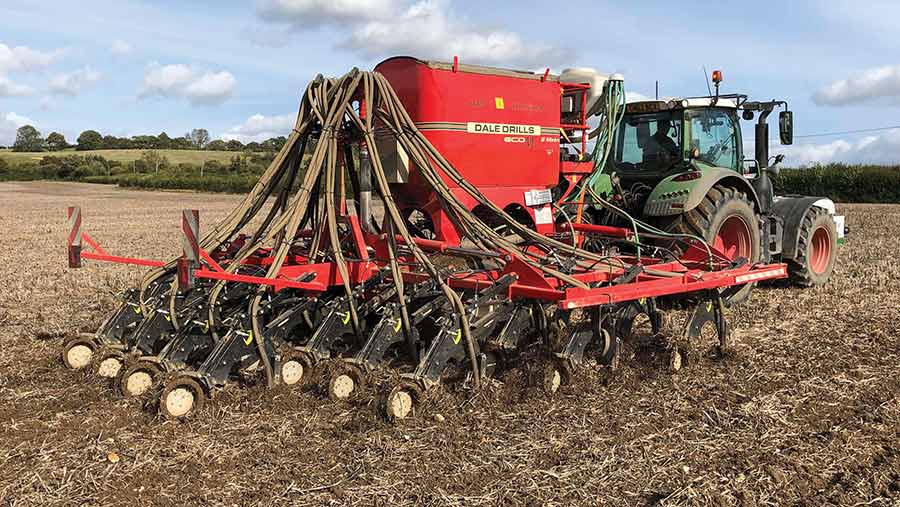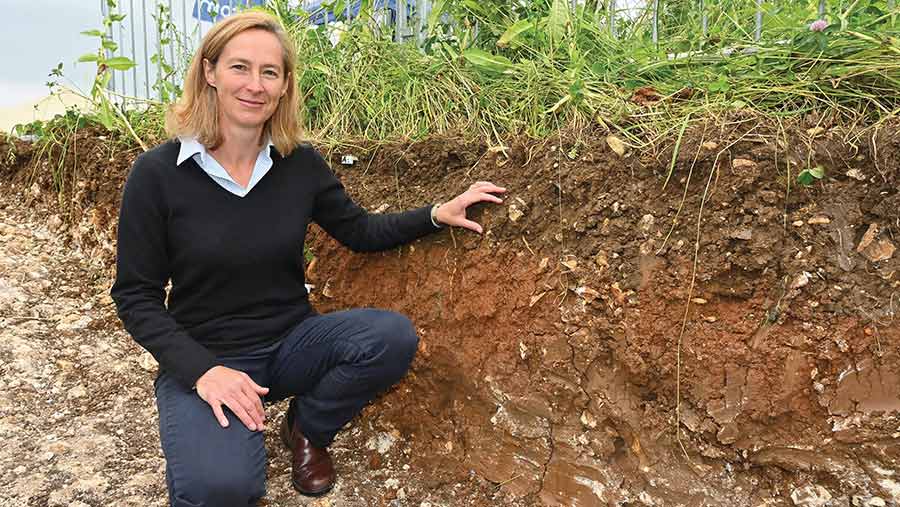Direct-drilling: Main findings from major five-year trial
 Dale drill used in conservation agriculture establishment trials © Syngenta
Dale drill used in conservation agriculture establishment trials © Syngenta Farming on heavy land in Leicestershire, Joe Stanley was skeptical that reducing cultivations by adopting a direct-drilling system would increase farm profitability and improve the environment.
But after seeing the hard data generated by a five-year project comparing three systems across two farms, he is now a direct-drilling convert, although he would still cultivate areas where needed.
The key project finding is that compared with a plough-based system, direct drilling can increase profitability as well as reduce greenhouse gas emissions and increase earthworm numbers.
See also: How OSR variety choice helps crops survive flea beetle
“It’s fantastic that you can do all this at the same time and all you need to do is change the establishment system,” he says.
As the head of training and partnerships at the Game and Wildlife Conservation Trust’s Loddington Farm, Joe has overseen the heavy land part of the trial.
Fully funded by Syngenta, the conservation agriculture project compared three different establishment systems at Loddington and on lighter land at Lenham in Kent.
The three systems are:
- Conventional plough based (15-20cm depth inversion)
- Min-till (10-15cm depth non-inversion cultivation + cover crops)
- Direct-drill (0-10cm depth light cultivation/direct-drill + cover crops)
The project generated 88,000 data points and Farmers Weekly looks at the key findings, verified by Niab.
Project at a glance
- The five-year trial stated in the autumn of 2017 and is part of a wider European project.
- Funded solely by Syngenta, partners include the Game and Wildlife Conservancy Trust and Niab.
- Aim Syngenta’s aim is to understand more about conservation agriculture and its effect on the environment and farm profitability. In addition, the company is exploring how inputs such as herbicides fit in a direct-drilling system.
- Length Five years to complete a full rotation.
- Sites Two farms are involved, the first at Loddington, Leicestershire, on heavy land with high rainfall and a blackgrass burden. The second at Lenham, Kent, is on lighter land with lower rainfall.
- Treatments Three: “Conventional” plough-based, “Sustainable 1” based on min-till cultivations, and “Sustainable 2”, which is light till/direct drill.
- Both farms used a Dale Ecodrill for the direct-drilling treatment.
- Measurements Looking at how the systems have affected two key areas: economics and the environment – which includes soil health and bird numbers.
- Data Monitoring generated 88,000 data points.
- Future The project will be running for another four years and will look more closely at how to optimise the direct-drilling system using inputs such as biostimulants and precision technology.
1. Environmental benefits
Starting with the environmental impact, bird surveys reveal an increase in numbers with the direct-drilling approach.
Syngenta’s sustainable farming manager, Belinda Bailey, puts this down to the increased food resources resulting from the greater ground cover.
Reduced cultivations also led to more earthworms, but the percentage increase was greater in Kent, as the light soil was starting at a lower level.
With soil health, positive trends are starting to be seen, although it’s still early days. Joe points to other work at Loddington which shows more than five years is needed before soil health changes are seen.

Belinda Bailey demonstrates the green cover for soil enhancement © Syngenta
“We weren’t expecting significant changes over that time period, as we haven’t been turbocharging the soils by adding manures or livestock. We have just been reducing tillage,” he says.
One clear benefit already evident is the 8% reduction in soil greenhouse gas emissions at Loddington. A similar 5% decrease was seen at the Kent farm.
When you plough, there is a burst of carbon loss from the breakdown of organic matter, Joe explains.
Another source is the breakdown of nitrates into nitrous oxide in soils that are waterlogged, perhaps resulting from soil compaction.
He points out that nitrous oxide is 300 times more warming than carbon dioxide.
On heavier soils, compaction may therefore need to be managed in a reduced-tillage system. If compaction was a problem, Joe is open to carrying out low-disturbance subsoiling.
“Hopefully, we can manage compaction with cover crops, but sometimes you have to use metal,” he says.
2. Yield and economics
With crop performance, one effect of direct drilling was the lower crop establishment rate. Belinda says part of this is down to using the same seed rates across all the treatments.
Joe adds that growers would normally increase the rate when direct-drilling, as establishment can be more challenging. But because it was a trial, it was kept constant.
For the heavy land farm, this reduced plant population led to a yield penalty, with the effect being greatest in spring crops.
On the higher-yield-potential Kent site, yield was unchanged as crops were able to compensate in the more favourable soil.
Joe also points out that the past five years have seen unprecedented conditions.
“Had we seen more normal years, the yield penalty may have been smaller.”
The very wet autumn and winter in 2019 saw no winter crops drilled at Loddington, and even this spring not a single field of spring crops had been drilled at the time of the visit on 19 April.
Looking ahead, by increasing seed rates and using biostimulants to increase establishment rates, Joe believes he can close this yield gap.
“We will also see better establishment as soils improve, as we have seen elsewhere on the Allerton Estate under long-term direct-drilling.”
Another factor that may help establishment is the improved work rates with direct drilling.
“There is more potential to drill at the optimum time, as work rates under the direct-drill system are twice that of the ploughed”.
Cover crops
One learning point from the trial was how to manage cover crops, especially timing their destruction before spring drilling. “In Kent, you can leave them in for longer,” Joe says.
At Loddington, cover crops are destroyed in mid-January, two months ahead of drilling. This gives soils time to dry out and the biomass to degrade.
The cover crop species mix is also tailored to fast-growing species and clovers are not in long enough to fix nitrogen, “so we don’t bother”, he adds.
While blackgrass is an issue at Loddington and there have been patches in some fields, after five years, none of the treatments have had a negative effect on the grassweed.
Direct drilling has also had a beneficial effect on cabbage stem flea beetle in OSR, especially in Kent.
For example, Belinda says one season they lost the whole plough-established crop, but 85% of plants remained in the direct-drilled plot.
Joe believes it is related to moisture levels, with crops getting away better. Direct drilling conserves moisture and when ploughing, the dry conditions hamper the crop’s ability to grow away from the adult flea beetle attacks.
Looking at gross margins, the reduction in yield at Loddington meant there was only a small increase, despite the 44-45% lower fuel use and 11% lower operation cost.
In Kent, where crop yields were unaffected, the cost benefits translated to a 9% improvement in grain gross margin.
But as Joe points out, it’s not just about gross output and yield, it is about maximising profitability.
So when taking the lower capital cost and lower tractor horsepower requirement into account, there was a clear benefit on net profit at both farms, with a 14-16% increase.
The lower horsepower requirement is appealing given the recent sharp increase in machinery costs.
“There has been a 40% increase for anything with an engine since 2016,” says Joe.
In addition to this, he says, there is the time saving of two weeks of cultivations during the busiest time of the year, which is valuable considering the difficulty in recruiting staff.
Direct drilling, with its lower costs, has taken some of the risk out of the system at Loddington, adding resilience.
“We are currently seeing rising input costs and falling grain prices, which means direct drilling has been more beneficial this year.”
In conclusion, Joe says moving to direct drilling helps farmers become lower their carbon footprint and be more profitable.
“It will work not just in Kent, but on heavy land too,” he says.
He adds that the new Sustainable Farming Incentive may encourage farmers to do more direct drilling, and this project shows how it might benefit them.
Next phase
Data shows that moving to a direct-drilling system has cut the farm’s carbon footprint by 4-9%, but the question is whether farmers can optimise more efficient use of inputs, according to Belinda.
This will be one of the questions addressed in the next four-year stage, where carbon sequestration will also be measured.
The min-till treatment has always been the halfway house in terms of the environmental impact, so this is being dropped for a new direct-drilling plus treatment setup, along side the existing control and direct-drilling treatment, she says.
This new treatment will bring everything together to see how the system can be improved.
There will be a focus on raising establishment rates and using manures and rotational fallows, making it more of a regenerative system.
The thinking is that this could lead to a more radical change in soil health.
Data at a glance |
||
|
|
Lenham |
Loddington |
|
Soil greenhouse gas emissions |
-5% |
-8% |
|
Earthworm numbers |
+112% |
+13% |
|
Carbon footprint |
-9% |
-4% |
|
Crop establishment |
-5% |
-8% |
|
Yield |
0% |
-7% |
|
Fuel use |
-45% |
-44% |
|
Work rate |
+52% |
+50% |
|
Operation cost |
-7% |
-11% |
|
Gross margin |
+9% |
+1% |
|
Net profit |
+16% |
+14% |

